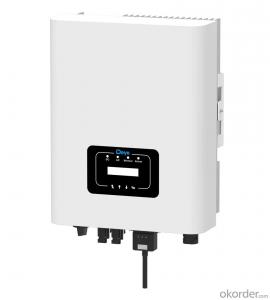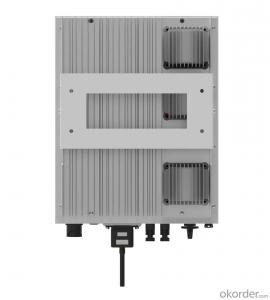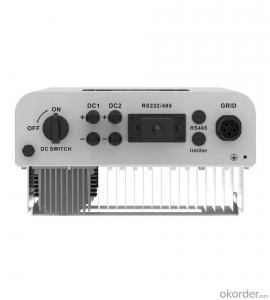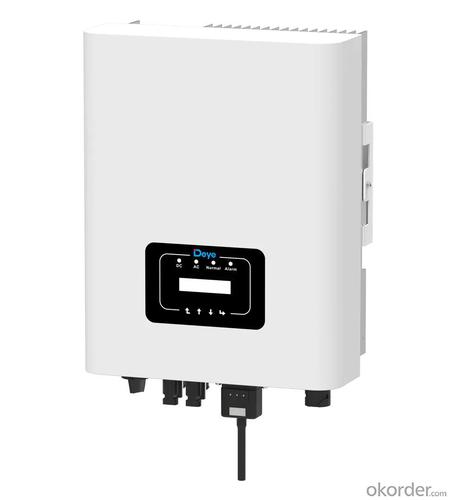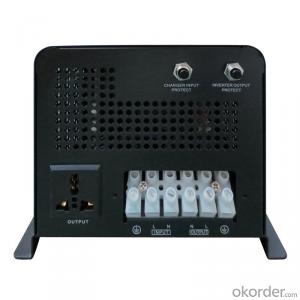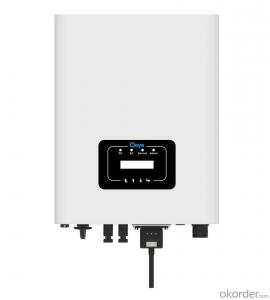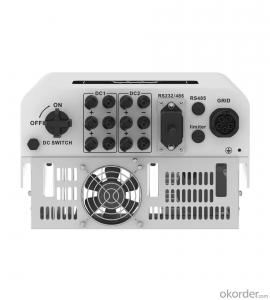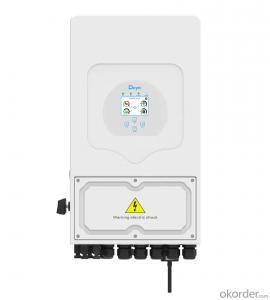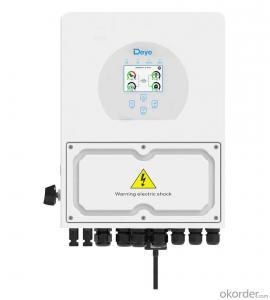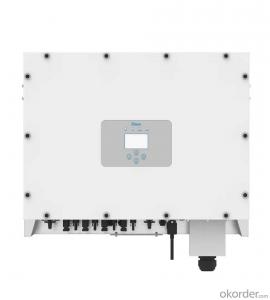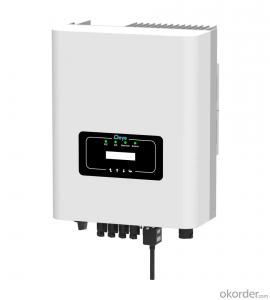3000W Solar Inverter - sun-4/5/6/7/8/10/12k-g05-p | 4-12kW | Three Phase | 2 MPPT
- Loading Port:
- Ningbo
- Payment Terms:
- TT OR LC
- Min Order Qty:
- 100 pc
- Supply Capability:
- 5000 pc/month
OKorder Service Pledge
Quality Product, Order Online Tracking, Timely Delivery
OKorder Financial Service
Credit Rating, Credit Services, Credit Purchasing
You Might Also Like
Specification
Output Power:
4kw-12kw
Inveter Efficiency:
97.5%
Output Voltage(V):
380
Input Voltage(V):
550
Output Current(A):
5.8-17.4
Output Frequency:
50/60Hz
| Model | SUN-4K-G05-P | SUN-6K-G05-P | SUN-7K-G05-P | SUN-7K-G05-P | SUN-8K-G05-P | SUN-10K-G05-P | SUN-12K-G05-P | |
| Input Side | ||||||||
| Max. DC Input Power (kW) | 5.2 | 6.5 | 7.8 | 9.1 | 10.4 | 13 | 15.6 | |
| Max. DC Input Voltage (V) | 1000 | |||||||
| Start-up DC Input Voltage (V) | 140 | 250 | ||||||
| MPPT Operating Range (V) | 120~850 | 200~850 | ||||||
| Max. DC Input Current (A) | 20+20 | |||||||
| Max. Short Circuit Current (A) | 30+30 | |||||||
| No.of MPP Trackers | 2 | |||||||
| No.of Strings per MPP Tracker | 1 | |||||||
| Output Side | ||||||||
| Rated Output Power (kW) | 4 | 5 | 6 | 7 | 8 | 10 | 12 | |
| Max. Active Power (kW) | 4.4 | 5.5 | 6.6 | 7.7 | 8.8 | 11 | 13.2 | |
| Nominal Output Voltage / Range (V) | 3L/N/PE 380V/0.85Un-1.1Un, 400V/0.85Un-1.1Un | |||||||
| Rated Grid Frequency (Hz) | 50 / 60 (Optional) | |||||||
| Operating Phase | Three phase | |||||||
| Rated AC Grid Output Current (A) | 5.8 | 7.2 | 8.7 | 10.1 | 11.6 | 14.5 | 17.4 | |
| Max. AC Output Current (A) | 6.4 | 8 | 9.6 | 11.1 | 12.8 | 15.9 | 19.1 | |
| Output Power Factor | 0.8 leading to 0.8 lagging | |||||||
| Grid Current THD | <3% | |||||||
| DC Injection Current (mA) | <0.5% | |||||||
| Grid Frequency Range | 47~52 or 57~62 (Optional) | |||||||
| Efficiency | ||||||||
| Max. Efficiency | 98.3% | |||||||
| Euro Efficiency | 97.5% | |||||||
| MPPT Efficiency | >99% | |||||||
| Protection | ||||||||
| DC Reverse-Polarity Protection | Yes | |||||||
| AC Short Circuit Protection | Yes | |||||||
| AC Output Overcurrent Protection | Yes | |||||||
| Output Overvoltage Protection | Yes | |||||||
| Insulation Resistance Protection | Yes | |||||||
| Ground Fault Monitoring | Yes | |||||||
| Anti-islanding Protection | Yes | |||||||
| Temperature Protection | Yes | |||||||
| Integrated DC Switch | Yes | |||||||
| Remote software upload | Yes | |||||||
| Remote change of operating parameters | Yes | |||||||
| Surge protection | DC Type II / AC Type II | |||||||
| General Data | ||||||||
| Size (mm) | 330W×457H×185D | 330×457×205 | ||||||
| Weight (kg) | 10 | 11 | ||||||
| Topology | Transformerless | |||||||
| Internal Consumption | <1W (Night) | |||||||
| Running Temperature | -25~65℃, >45℃ derating | |||||||
| Ingress Protection | IP65 | |||||||
| Noise Emission (Typical) | <30 dB | |||||||
| Cooling Concept | Natural cooling | |||||||
| Max. Operating Altitude Without Derating | 2000m | |||||||
| Warranty | 5 years | |||||||
| Grid Connection Standard | CEI 0-21, VDE-AR-N 4105, NRS 097, IEC 62116, IEC 61727, G99, G98, VDE 0126-1-1, RD 1699, C10-11 | |||||||
| Operating Surroundings Humidity | 0-100% | |||||||
| Safety EMC / Standard | IEC/EN 61000-6-1/2/3/4, IEC/EN 62109-1, IEC/EN 62109-2 | |||||||
| Features | ||||||||
| DC Connection | MC-4 mateable | |||||||
| AC Connection | IP65 rated plug | |||||||
| Display | LCD1602 | |||||||
| Interface | RS485/RS232/Wifi/LAN | |||||||
This series inverter is specially designed for three-phase PV systems, covering a wide power range of 4kW, 5kW, 6kW, 7kW, 8kW, 10kW, 12kW. With compactness design, it is easy to install and operate. It supports wide AC output voltage to ensure longer working hour.
· 2 MPP tracker, Max. efficiency up to 98.3%
· Zero export application, VSG application
· String intelligent monitoring (optional)
· Wide output voltage range
· Anti-PID function (Optional)
- Q: What are the potential risks of electrical shock from a solar inverter?
- The potential risks of electrical shock from a solar inverter include: 1. Improper installation or faulty wiring, which may result in exposed live wires and increase the chances of electric shock. 2. Inadequate grounding or lack of proper safety measures, leading to the possibility of electrical leakage and shock hazards. 3. Accidental contact with energized components during maintenance or repair work, especially if proper safety precautions are not followed. 4. Inverter malfunctions or defects, such as insulation breakdown, which can expose individuals to electric shock. 5. Working with solar inverters in wet or damp conditions, as moisture can increase the conductivity of electricity and heighten the risk of shock. 6. Ignoring warning signs or not following manufacturer guidelines for safe operation and maintenance, which can contribute to electrical shock incidents.
- Q: How does a solar inverter impact the payback period of a solar system?
- A solar inverter can have a significant impact on the payback period of a solar system. The efficiency and reliability of a solar inverter can affect the overall energy production and performance of the solar system. A high-quality inverter can optimize the conversion of solar energy into usable electricity, maximizing the system's output and reducing energy losses. This improved efficiency can shorten the payback period by increasing the amount of electricity generated and therefore the savings on utility bills. Additionally, a reliable inverter can minimize maintenance and replacement costs, further enhancing the financial returns of the solar investment.
- Q: Can a solar inverter be used with a smart home automation system?
- Yes, a solar inverter can be used with a smart home automation system. Many modern solar inverters are equipped with communication interfaces such as Wi-Fi or Zigbee, allowing them to integrate seamlessly with smart home automation systems. This integration enables homeowners to monitor and control their solar energy production, consumption, and storage remotely, and optimize their energy usage for increased efficiency and cost savings.
- Q: Can a solar inverter be used with batteries for energy storage?
- Yes, a solar inverter can be used with batteries for energy storage. In fact, this combination is commonly used in residential and commercial solar systems to store excess solar energy generated during the day and use it later when the sun is not shining, such as at night or during power outages. The solar inverter converts the DC power from the solar panels into AC power for immediate consumption or for charging the batteries. The batteries then store the excess energy for later use, providing a reliable and continuous power supply.
- Q: Can a solar inverter be used with a ground-mounted solar array?
- Yes, a solar inverter can be used with a ground-mounted solar array. A solar inverter is responsible for converting the DC (direct current) electricity produced by the solar panels into AC (alternating current) electricity that can be used to power homes or businesses. Whether the solar array is ground-mounted or roof-mounted, the solar inverter plays a crucial role in converting the electricity for use in the desired location.
- Q: Can a solar inverter be used with a time-of-use electricity tariff?
- Yes, a solar inverter can be used with a time-of-use electricity tariff. Time-of-use electricity tariffs typically involve different rates for electricity consumption based on the time of day. A solar inverter can be programmed to produce and export excess solar energy during peak times when electricity rates are higher, and import energy from the grid during off-peak times when rates are lower. This allows users to optimize their energy consumption and potentially save on electricity costs.
- Q: Are there any specific installation requirements for solar inverters?
- Yes, there are specific installation requirements for solar inverters. Here are some key considerations: 1. Location: Solar inverters should be installed in a well-ventilated area, away from direct sunlight or any potential sources of heat. They should also be placed in a clean and dry environment to ensure optimal performance and longevity. 2. Mounting: Inverters can be mounted on walls or placed on flat surfaces, but it is important to follow the manufacturer's guidelines for proper mounting techniques and ensure that they are securely fastened. 3. Wiring: Adequate wiring is essential for connecting the solar panels to the inverter and the inverter to the electrical grid. The wiring should be properly sized, based on the system's specifications, to handle the voltage and current requirements without any voltage drop or overheating. 4. Electrical connections: The inverter should be connected to a dedicated circuit breaker or fuse in the main electrical panel. This circuit breaker or fuse should be properly sized to protect the inverter and the electrical system from any potential hazards. 5. Clearances: Solar inverters require specific clearances to ensure proper ventilation and prevent overheating. The manufacturer's guidelines should be followed to determine the necessary clearances around the inverter. 6. Monitoring and safety devices: Some inverters require additional monitoring and safety devices, such as surge protectors, arc fault circuit interrupters (AFCIs), or rapid shutdown devices. These devices should be installed according to the manufacturer's instructions and local electrical codes. 7. Compliance with regulations: It is crucial to comply with local electrical codes and regulations when installing solar inverters. This may include obtaining necessary permits and inspections to ensure a safe and compliant installation. It is recommended to consult with a professional solar installer or electrician who is knowledgeable about solar inverter installations to ensure that all the specific requirements are met for your particular system.
- Q: Can a solar inverter be repaired or replaced if it malfunctions?
- Yes, a solar inverter can be repaired or replaced if it malfunctions. In many cases, minor issues can be resolved through repairs, such as replacing faulty components or fixing wiring problems. However, if the malfunction is severe or the inverter is beyond repair, it may need to be replaced with a new one.
- Q: What is the maximum input voltage that a solar inverter can handle?
- The maximum input voltage that a solar inverter can handle depends on the specific model and make of the inverter. It can vary widely, but typically ranges between 600V to 1000V DC for residential inverters, and higher for commercial or utility-scale inverters.
- Q: How do you choose the right size of solar inverter for a system?
- To choose the right size of solar inverter for a system, several factors need to be considered. Firstly, you should determine the total capacity of the solar panels in the system. The inverter's maximum input power rating should be equal to or slightly higher than the total capacity of the panels. Additionally, the inverter's voltage rating should match the system's voltage requirements. It is also crucial to consider the inverter's efficiency, as a higher efficiency rating will ensure better conversion of solar energy into electricity. Lastly, it is advisable to consult a professional or use online calculators to accurately determine the appropriate size of the inverter based on the specific needs and requirements of the system.
Send your message to us
3000W Solar Inverter - sun-4/5/6/7/8/10/12k-g05-p | 4-12kW | Three Phase | 2 MPPT
- Loading Port:
- Ningbo
- Payment Terms:
- TT OR LC
- Min Order Qty:
- 100 pc
- Supply Capability:
- 5000 pc/month
OKorder Service Pledge
Quality Product, Order Online Tracking, Timely Delivery
OKorder Financial Service
Credit Rating, Credit Services, Credit Purchasing
Similar products
Hot products
Hot Searches
Related keywords
